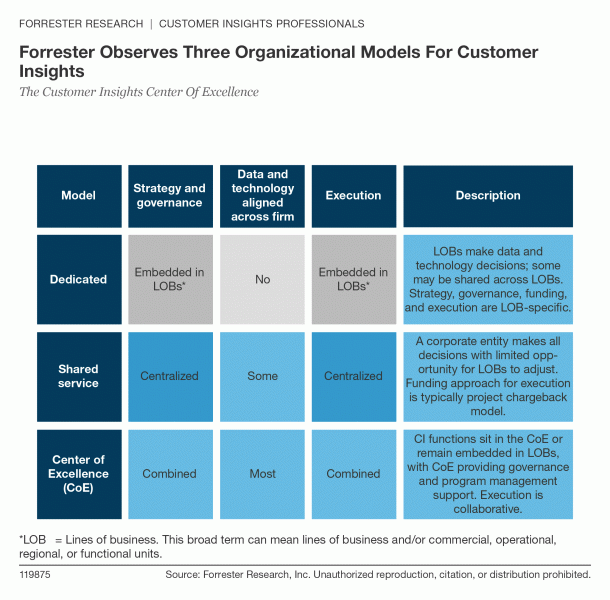You Need a Customer Insights Center of Excellence – Get Started With What You Have Now
There’s a big insights gap out there. Not enough insights are turning into actions that matter, despite continued investment in data, people, and technology. For example, in 2016, data and analytics pros reported that firms base only 49% of business decisions on quantitative information and analysis as opposed to opinion. That’s up from 2015, but only by 3 percentage points – out of alignment with the investment in insights capabilities. You feel the pressure, I know. So, it's action time – to drive more value from insights.
For sure, firms today have bright spots of insights value – for example, in digital channels, where A/B and other testing approaches enable continuous optimization of customer interactions that matter most to business outcomes. But disparate bright spots are not enough, and businesses must move from insights-spotty to insights-driven. Research by Forrester colleagues Brian Hopkins, James McCormick, and Ted Schadler paints the picture of what great looks like in insights-driven business. Such firms organize and operate differently to take advantage of data and analytics in every aspect of their products and operations, and that closed-loop approach is embedded everywhere in the organization. That's the end goal. Customer insights teams must up their game now, and a center of excellence (CoE) is a first step.
In my report on this topic, I noted that forming a customer insights CoE is not a one-and-done project. It’s an organizational change initiative. A small team – the CoE — drives culture and process shift through strategy, governance, and program management (see chart below). The goal: drive continuous increases in insights leading to actions that matter. Here are a couple of tactics to use to get started now, even if your CoE is a virtual organization at the outset:
Sneak up on success. Even when time is of the essence, a winding path can sometimes be the most direct path to success. CoE team members must both serve their business partner stakeholders and guide them by painting a picture of a new metric, or a new data capability that makes them say (or at least think), “I need more of that to meet my objectives.” Engage your business partners, but don’t fall into the role of order-taker. You could, for example, collaborate on a new report your stakeholder needs for an upcoming executive presentation. Or, keeping the scope small, you could re-craft a report or dashboard that a business partner can interact with on their own. Once the business partner is engaged, there’s opportunity to guide them – do something new, such as combining data types for new insights, or getting two or more stakeholders to align around a common, customer-centric metric.
Celebrate wins – and talk them up. Deliver wins with what you have right now – and build from there. This takes creative craftiness. To make progress, stop yourself from getting stymied because you feel you need XYZ resources to take that next step. The best way to attract energy – and ultimately resources – is to find and deliver small wins now. Maybe that measns a view of customer data you provide that starts conversations about metrics that currently have line-of-business-specific definitions – and don’t need to. Or, you can reinvigorate a small pilot that was tried in the past and didn’t get off the ground – but could now. Once you have small wins, tell engaging, easy-to-remember customer-centric stories about them. Avoid death by slides.

